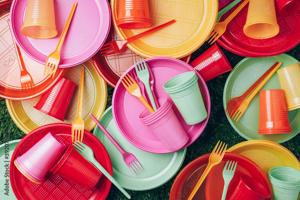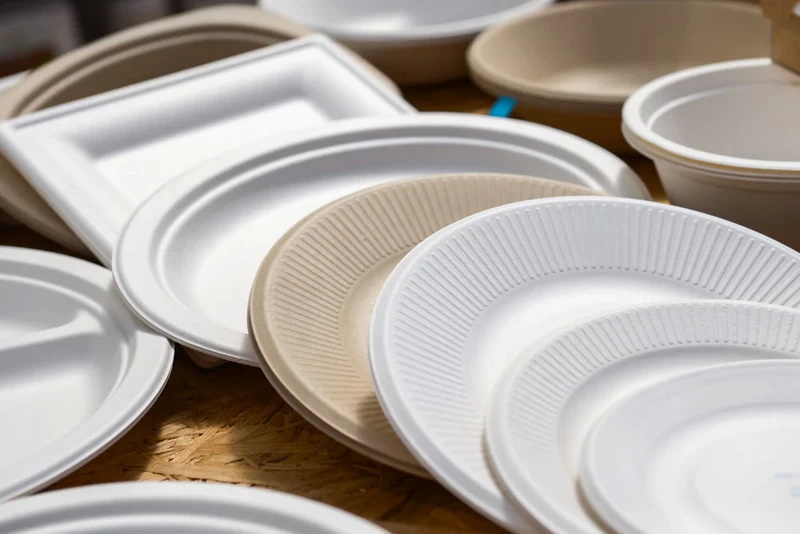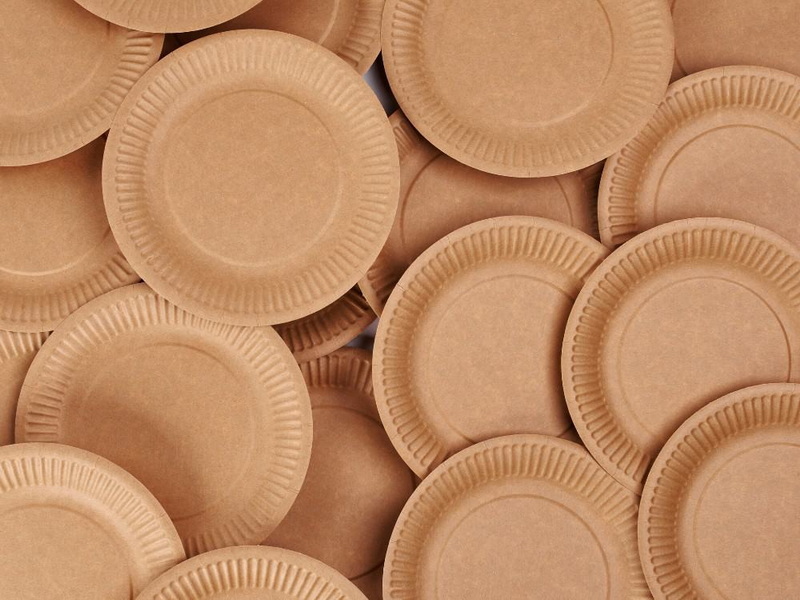
Content Menu
● The Importance of Recycling
● Types of Plastic Plates
● Are Plastic Disposable Plates Recyclable?
● The Recycling Process
● Common Misconceptions About Recycling Plastic Plates
● Environmental Impact of Plastic Waste
● Alternatives to Plastic Disposable Plates
● Innovations in Biodegradable Plastics
● The Role of Consumer Awareness
● Conclusion
● FAQ
>> 1. Can all types of plastic disposable plates be recycled?
>> 2. What should I do before recycling my plastic plates?
>> 3. Are there eco-friendly alternatives to plastic disposable plates?
>> 4. How long does it take for plastic to decompose in landfills?
>> 5. What can I do if my local recycling program doesn't accept plastic plates?
The increasing prevalence of plastic waste has raised significant concerns about its impact on the environment. As disposable plastic plates become a common choice for parties, picnics, and gatherings, understanding their recyclability is crucial in our efforts to reduce plastic pollution. This article explores the recyclability of plastic disposable plates, the types of plastics involved, the recycling process, and alternative options available.

The Importance of Recycling
Recycling plays a vital role in minimizing the environmental footprint of plastic products. By recycling, we can:
- Reduce Waste: Recycling helps divert materials from landfills, decreasing overall waste.
- Conserve Resources: It allows for the reuse of materials, reducing the need for virgin resources.
- Protect Wildlife: Proper disposal prevents animals from ingesting or becoming entangled in plastic debris.
- Support a Circular Economy: Recycling fosters a sustainable system where materials are continuously reused.
Types of Plastic Plates
Plastic disposable plates are typically made from various types of plastics, each with different recycling capabilities. The most common types include:
- Polypropylene (PP): Often used for sturdy disposable plates, marked with recycling code #5. These are generally recyclable in many areas.
- Polystyrene (PS): Commonly used for cheaper plates and marked with recycling code #6. These are less frequently accepted in curbside recycling programs.
- Polyethylene Terephthalate (PET): While typically used for drink containers, some disposable plates may also use this material, marked with recycling code #1.
Understanding these classifications is essential for proper disposal and recycling.
Are Plastic Disposable Plates Recyclable?
The short answer is that some plastic disposable plates are recyclable, but it depends on the type of plastic and local recycling regulations. Here's a breakdown:
- Recyclable Plates: Plates made from PP (#5) can often be recycled if clean and free from food residue. Many curbside recycling programs accept these plates.
- Non-Recyclable Plates: Plates made from PS (#6) are often not accepted in curbside recycling due to their low-grade plastic nature. They usually end up in landfills.
The Recycling Process
Recycling plastic plates involves several steps to ensure they are processed correctly:
1. Collection: Used plates are collected from households or businesses.
2. Sorting: At a recycling facility, plates are sorted by type and color. This step is crucial as different plastics require different processing methods.
3. Cleaning: Plates must be cleaned to remove food residues and contaminants that could interfere with the recycling process.
4. Shredding: Cleaned plates are shredded into small pieces.
5. Melting and Pelletizing: The shredded plastic is melted down and formed into pellets that can be used to create new products.
6. Manufacturing New Products: These pellets can then be used to manufacture various items, such as containers or even new plates.

Common Misconceptions About Recycling Plastic Plates
Despite some plastics being recyclable, several misconceptions persist:
- All Plastic Plates Are Non-Recyclable: This is false; only specific types (like PS) are non-recyclable.
- Recycling Is Not Economically Viable: While initial costs may be higher than producing new plastics, the long-term benefits of reducing landfill waste and conserving resources outweigh these costs.
- Recycling Is Not Environmentally Friendly: Although recycling requires energy, it significantly reduces the environmental impact compared to producing new plastics from raw materials.
Environmental Impact of Plastic Waste
The environmental consequences of plastic waste extend beyond just landfills. Key issues include:
- Ocean Pollution: Millions of tons of plastic enter oceans annually, harming marine life through ingestion or entanglement.
- Microplastics: As plastics break down into smaller particles, they enter the food chain and can affect human health when consumed through seafood or contaminated water sources.
- Greenhouse Gas Emissions: The production and incineration of plastics contribute to greenhouse gas emissions, exacerbating climate change.
Alternatives to Plastic Disposable Plates
Given the environmental concerns associated with single-use plastics, many consumers are seeking alternatives:
- Compostable Plates: Made from materials like sugarcane bagasse or bamboo, these plates break down naturally without harming the environment. They offer a sustainable option for those looking to reduce their ecological footprint.
- Reusable Plates: Investing in reusable dinnerware can significantly reduce waste over time. Options include stainless steel, glass, or durable BPA-free plastics that can withstand multiple uses without degradation.
- Paper Plates: While still single-use, paper plates tend to have a lower environmental impact than plastic if sourced sustainably. Look for products made from recycled paper or certified by organizations like the Forest Stewardship Council (FSC).
Innovations in Biodegradable Plastics
Recent advancements in technology have led to the development of biodegradable plastics that offer an alternative to traditional petroleum-based plastics:
- PLA (Polylactic Acid): Derived from renewable resources like corn starch or sugarcane, PLA is compostable under industrial conditions but may not break down effectively in home composting systems.
- PHA (Polyhydroxyalkanoates): Produced by microbial fermentation of organic materials, PHA is biodegradable in various environments, including marine settings.
These innovations represent a significant step toward reducing reliance on conventional plastics while addressing waste management challenges.
The Role of Consumer Awareness
Consumer choices play a pivotal role in shaping market demand for sustainable products:
- Educating Yourself and Others: Understanding which products are recyclable or compostable helps consumers make informed choices that benefit the environment.
- Supporting Sustainable Brands: Opting for companies that prioritize eco-friendly materials and practices encourages more businesses to shift towards sustainable production methods.
- Advocating for Better Recycling Programs: Engaging with local government and community organizations can lead to improved recycling infrastructure and education initiatives that promote responsible disposal practices.
Conclusion
The recyclability of plastic disposable plates largely depends on their material composition and local recycling capabilities. While some types like polypropylene can be recycled effectively, others like polystyrene often cannot. As consumers become more environmentally conscious, exploring alternatives such as compostable or reusable options can significantly reduce our reliance on single-use plastics.
By making informed choices about disposable dinnerware, we can contribute to a more sustainable future and help mitigate the growing problem of plastic waste.

FAQ
1. Can all types of plastic disposable plates be recycled?
Not all types; only polypropylene (#5) is commonly recyclable in many areas. Polystyrene (#6) is typically not accepted in curbside programs.
2. What should I do before recycling my plastic plates?
Ensure they are clean and free from food residues to avoid contamination during the recycling process.
3. Are there eco-friendly alternatives to plastic disposable plates?
Yes! Compostable plates made from materials like bamboo or sugarcane are great alternatives that break down naturally.
4. How long does it take for plastic to decompose in landfills?
Plastic can take hundreds of years to decompose fully; however, it breaks down into smaller microplastics much sooner, which can harm ecosystems.
5. What can I do if my local recycling program doesn't accept plastic plates?
Consider using reusable dinnerware or look for local composting facilities that may accept compostable alternatives instead.

















